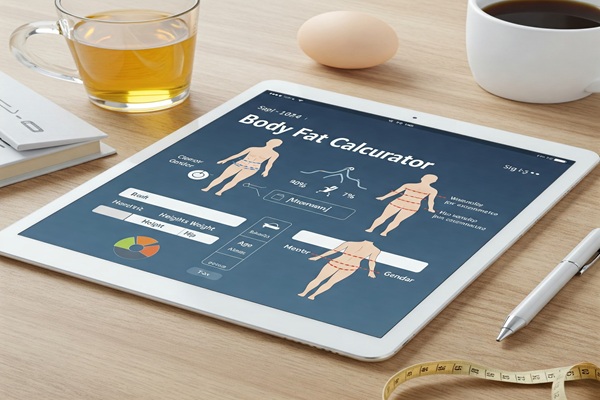Enter Your Measurements
Fill in the form below to calculate your body fat
Your Calculation History
Track your progress over time
No calculations yet
Your previous calculations will appear here
Understanding Body Fat Percentage
Learn what body fat percentage means and how it impacts your health and fitness
What is Body Fat Percentage?
Body fat percentage is the amount of fat mass in your body compared to your total body weight. It includes both essential fat (needed for basic physiological functions) and storage fat (accumulated adipose tissue).
Body Fat % = (Fat Mass / Total Weight) × 100
Unlike BMI, which can't distinguish between fat and muscle, body fat percentage directly measures the composition of your body, making it a more accurate indicator of health and fitness.
Types of Body Fat
Essential Fat
Critical for normal physiological functions. For men, it's about 2-5% of total body weight, while for women it's 10-13% due to reproductive needs.
Subcutaneous Fat
Located beneath the skin. This is the fat that you can pinch and is used in skinfold measurements. It's less metabolically harmful than visceral fat.
Visceral Fat
Surrounds internal organs in the abdominal cavity. High amounts are linked to increased health risks like heart disease, type 2 diabetes, and certain cancers.
Brown Fat
Specialized fat that generates heat by burning calories. It's more prevalent in lean individuals and can help with weight management and metabolic health.
Healthy Body Fat Ranges
| Classification | Men (%) | Women (%) | Health Risk |
|---|---|---|---|
| Essential Fat | 2-5% | 10-13% | Too low - risk of hormonal issues |
| Athletes | 6-13% | 14-20% | Excellent |
| Fitness | 14-17% | 21-24% | Very Good |
| Average | 18-24% | 25-31% | Moderate |
| Obese | 25%+ | 32%+ | Increased health risks |
Age is an important factor: healthy body fat percentages typically increase slightly with age. For example, a healthy range for a 20-year-old man might be 8-19%, while for a 60-year-old man it might be 13-24%.
Measurement Methods
Navy Method
Uses circumference measurements of specific body parts along with height and weight to estimate body fat percentage.
For Men:
- Neck circumference
- Waist circumference
For Women:
- Neck circumference
- Waist circumference
- Hip circumference
Jackson-Pollock Methods
Uses skinfold measurements from specific sites on the body to estimate body fat percentage. Multiple variations exist based on the number of measurement sites:
3-Site Method
Uses three measurement sites, different for men and women. Quick and reasonably accurate for most people.
4-Site Method
Uses four measurement sites, providing better accuracy for a wider range of body types.
7-Site Method
Uses seven measurement sites, offering the highest accuracy among skinfold methods.
Advanced Methods
DEXA Scan
Dual-energy X-ray absorptiometry is considered the gold standard for body composition analysis.
Accuracy: ±1-2%Hydrostatic Weighing
Underwater weighing uses the Archimedes principle to determine body density and calculate fat percentage.
Accuracy: ±1.5-3%Why Body Fat Percentage Matters
Health Indicators
- Excess body fat is linked to increased risk of heart disease, type 2 diabetes, and certain cancers.
- Too little essential fat can lead to hormonal imbalances, reproductive issues, and weakened immune function.
- Body fat distribution (where fat is stored) is often more important than the total amount.
Fitness Applications
- Helps track progress during weight loss/gain programs more accurately than scale weight alone.
- Assists in setting realistic fitness goals based on individual body composition.
- For athletes, helps optimize performance by identifying ideal body composition for their sport.
Frequently Asked Questions
Common questions about body fat percentage and measurement
